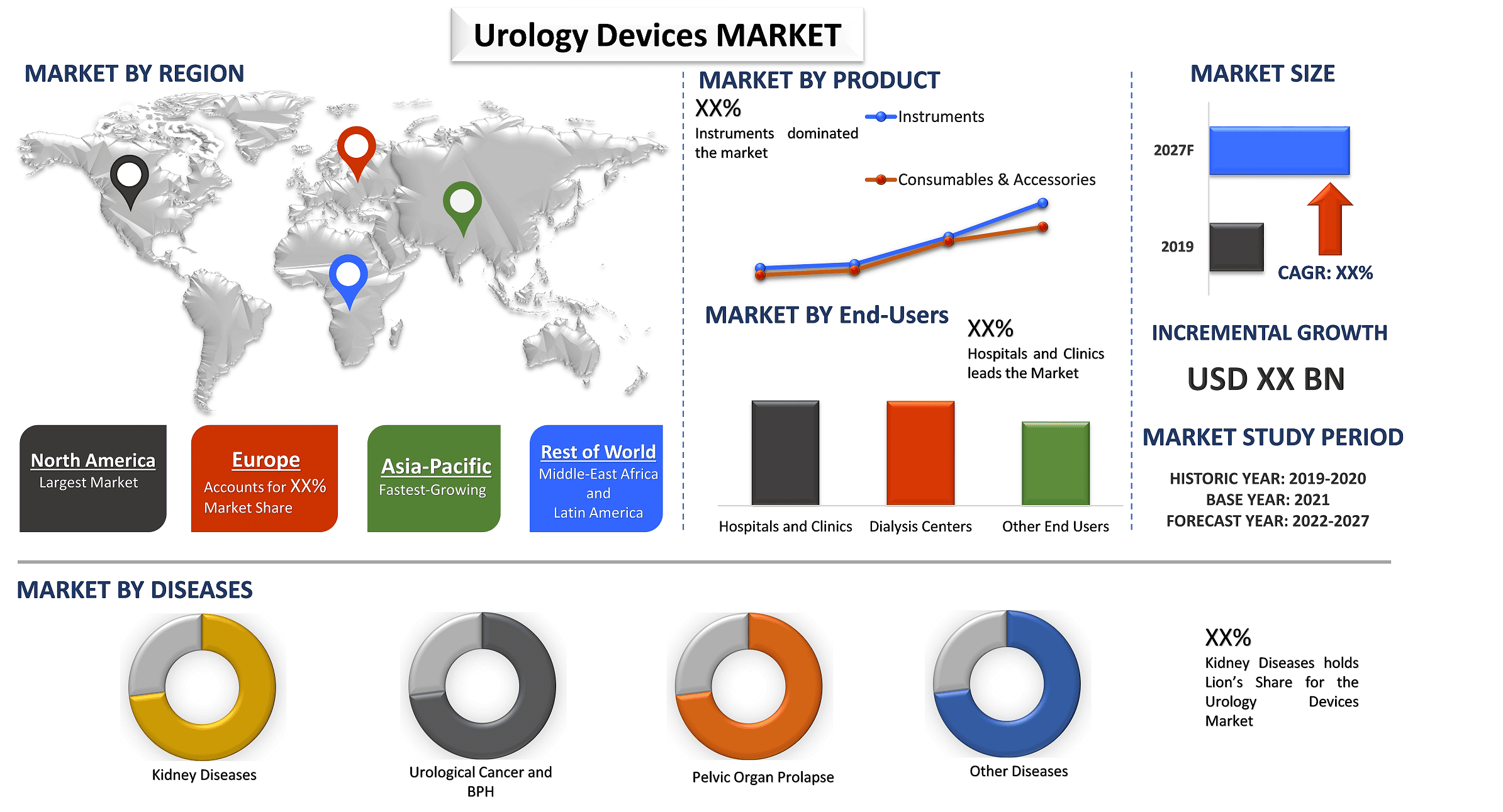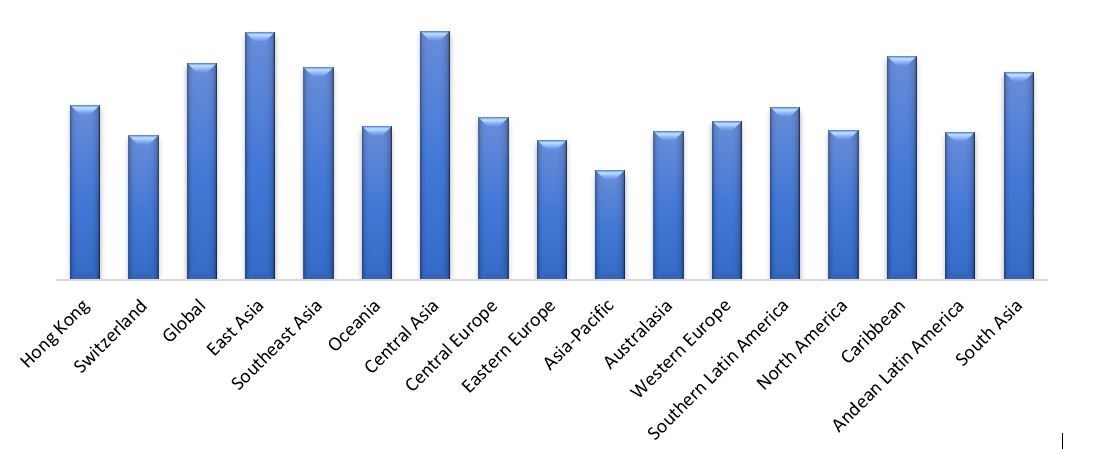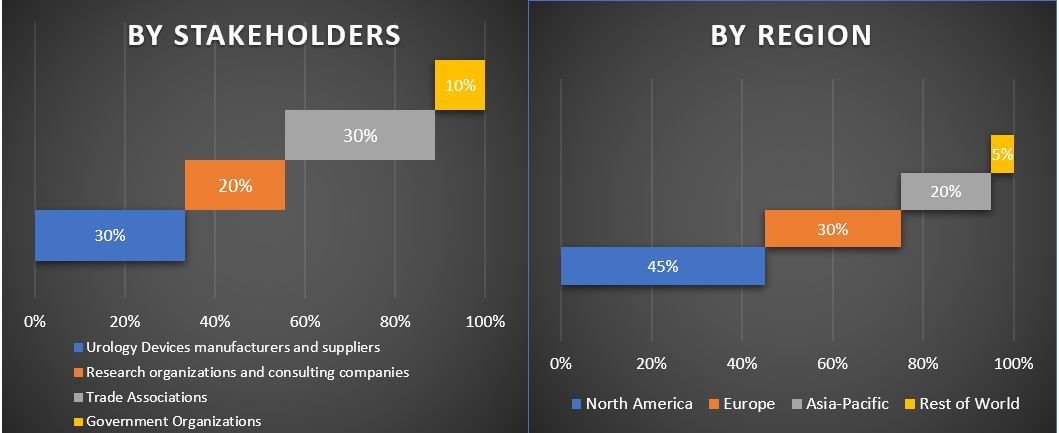- Trang chủ
- Về chúng tôi
- Ngành
- Dịch vụ
- Đọc
- Liên hệ với chúng tôi
Thị trường Thiết bị Tiết niệu: Phân tích và Dự báo Hiện tại (2021-2027)
Nhấn mạnh vào Sản phẩm (dụng cụ, vật tư tiêu hao & phụ kiện); Bệnh (Bệnh Thận, Ung thư Tiết niệu & BPH, Sa tạng chậu, Khác); Ứng dụng (Nhiễm khuẩn huyết, Nhiễm nấm huyết, Phát hiện vi khuẩn lao); Người dùng cuối (Bệnh viện & Phòng khám, Trung tâm chạy thận, Khác); Khu vực và Quốc gia

Sự gia tăng tỷ lệ mắc các bệnh tiết niệu khác nhau đã dẫn đến sự gia tăng việc sử dụng thiết bị tiết niệu trên toàn thế giới. Theo Quỹ Hiệp hội Tiết niệu Hoa Kỳ (AUAF), các bệnh tiết niệu phổ biến nhất bao gồm tăng sản tuyến tiền liệt lành tính (BPH), tiểu không tự chủ (UI), nhiễm trùng đường tiết niệu (UTIS) và sỏi thận và niệu quản. Hơn nữa,theo Bộ Y tế và Dịch vụ Nhân sinh Hoa Kỳ, tỷ lệ hiện mắc chung của CKD trong dân số Hoa Kỳ là khoảng 14% và gần một nửa số người mắc CKD bị bệnh tiểu đường và/hoặc bệnh tim mạch.Hơn661.000 người Mỹ được chẩn đoán suy thận mỗi năm, với 468.000 người được chạy thận. Nhiễm trùng đường tiết niệu (UTIs) là một bệnh nhiễm trùng do vi khuẩn thường gặp ảnh hưởng đến mọi người ở mọi lứa tuổi. Mỗi năm,khoảng 150 triệu người trên toàn thế giới bị ảnh hưởng bởi nhiễm trùng đường tiết niệu (UTIs). Bệnh nhân tiểu đường có nhiều khả năng bị nhiễm trùng đường tiết niệu (UTIs) và những hậu quả đi kèm với chúng. Khi dân số mắc bệnh tiểu đường toàn cầu tăng lên, các vấn đề như chứng khó tiểu và tổn thương cơ quan có liên quan đến UTIs, vốn cũng đang gia tăng.
Nhiễm trùng đường tiết niệu (UTIs) là một trong những bệnh do vi khuẩn phổ biến nhất ảnh hưởng đến mọi người ở mọi nhóm tuổi. Toàn cầu,UTIs ảnh hưởng đến khoảng 150 triệu người mỗi năm. Bệnh nhân tiểu đường có nguy cơ cao hơn bị UTIs và các biến chứng liên quan đến nó. Với sự gia tăng dân số mắc bệnh tiểu đường trên toàn cầu, các biến chứng, như chứng khó tiểu và tổn thương cơ quan có liên quan đến UTIs, vốn cũng đang gia tăng.
Hơn nữa, các yếu tố như sự gia tăng tỷ lệ mắc bệnh thận mạn tính đã dẫn đến nhu cầu về thiết bị tiết niệu ngày càng tăng trên toàn cầu. Năm 2017,tỷ lệ hiện mắc bệnh thận mạn tính cao nhất ở Đông Âu là 12.408 trên 100.000 dân. Để so sánh, tỷ lệ thấp nhất là 5.446 trên 100.000 dân được tìm thấy ở Tây Âu.
Tỷ lệ hiện mắc bệnh thận mạn tính trên toàn thế giới năm 2017, theo khu vực (trên 100.000 dân)
Baxter, Boston Scientific, C. R. Bard, Medtronic, Siemens, Fresenius Medical Care AG & Co. KGaA, B. Braun Melsungen AG, Becton, Dickinson and Company, Stryker Corporation và Sanofi là một số nhà sản xuất nổi bật đang hoạt động trên thị trường Thiết bị Tiết niệu toàn cầu. Một số hoạt động M&A cùng với quan hệ đối tác đã được các nhà sản xuất này thực hiện để tạo điều kiện cho khách hàng với các sản phẩm công nghệ cao và sáng tạo.
Thông tin chi tiết được trình bày trong Báo cáo
“Trong số các sản phẩm, phân khúc dụng cụ chiếm thị phần lớn”
Dựa trên sản phẩm, thị trường Thiết bị Tiết niệu toàn cầu được chia thành dụng cụ và vật tư tiêu hao & phụ kiện. Phân khúc dụng cụ chiếm lĩnh thị trường với thị phần XX% vào năm 2020 và dự kiến sẽ duy trì sự thống trị của mình trong giai đoạn dự báo do những tiến bộ công nghệ cùng với việc ra mắt các sản phẩm mới. Ví dụ, trongTháng 11 năm 2020, Baxter International Inc. (Mỹ) đã nhận được phê duyệt 510(k) từ FDA cho hệ thống chạy thận tự động Homechoice Claria với nền tảng kết nối Sharesource.
“Trong số các bệnh, bệnh thận dự kiến sẽ tăng trưởng với CAGR cao nhất trong giai đoạn phân tích”
Dựa trên các bệnh, thị trường được phân chia thành bệnh thận, ung thư tiết niệu và BPH, sa tạng chậu và các bệnh khác. Năm 2020, bệnh thận chiếm thị phần doanh thu thị trường tối đa là XX% và dự kiến sẽ vẫn chiếm ưu thế trong giai đoạn phân tích do sự gia tăng tỷ lệ mắc bệnh thận. Thiết bị Tiết niệu dựa trên Cyanobacter cung cấp chi phí đầu vào giảm, tăng khả dụng sinh học của phốt pho và giúp chu trình dinh dưỡng cũng như cố định nitơ. Theo CDC, hơn 1/7, tức là 15% người lớn ở Hoa Kỳ hoặc 37 triệu người, ước tính mắc CKD. Hơn nữa, vào năm 2018, khoảng 131.600 người ở Hoa Kỳ đã bắt đầu điều trị bệnh thận giai đoạn cuối (ESRD).
“Trong số những người dùng cuối, phân khúc bệnh viện và phòng khám dự kiến sẽ tăng trưởng với CAGR cao nhất trong giai đoạn phân tích”
Dựa trên người dùng cuối, thị trường được phân chia thành bệnh viện và phòng khám, trung tâm chạy thận và những người dùng cuối khác. Năm 2020, bệnh viện và phòng khám chiếm thị phần doanh thu thị trường tối đa là XX% và dự kiến sẽ vẫn chiếm ưu thế trong giai đoạn phân tích do số lượng bệnh viện ngày càng tăng và sự phát triển cơ sở hạ tầng, đặc biệt là ở các nước đang phát triển cùng với việc tăng các thủ tục phẫu thuật được thực hiện trong phòng mổ của bệnh viện. Ví dụ,tổng số bệnh viện ở Trung Quốc đã tăng đáng kể trong thập kỷ qua, từ khoảng 20 nghìn vào năm 2009 lên khoảng 34 nghìn bệnh viện vào năm 2019.
“Bắc Mỹ biểu thị một trong những thị trường lớn nhất của Thị trường Thiết bị Tiết niệu”
Để hiểu rõ hơn về động lực thị trường của thị trường Thiết bị Tiết niệu, một phân tích chi tiết đã được thực hiện cho các khu vực khác nhau trên toàn cầu bao gồm Bắc Mỹ (Hoa Kỳ, Canada và Phần còn lại của Bắc Mỹ), Châu Âu (Đức, Pháp, Ý, Tây Ban Nha, Vương quốc Anh và Phần còn lại của Châu Âu), Châu Á - Thái Bình Dương (Trung Quốc, Nhật Bản, Ấn Độ, Úc và Phần còn lại của APAC), Phần còn lại của Thế giới đã được thực hiện. Bắc Mỹ chiếm lĩnh thị trường và tạo ra doanh thu 20 tỷ USD vào năm 2020 do những tiến bộ công nghệ, tỷ lệ các trường hợp tiết niệu cao trong bệnh viện và tăng cường tài trợ. Ví dụ, vào năm 2018,785.883 người Mỹ bị suy thận và cần chạy thận hoặc cấy ghép thận để sống sót (2 trong số 1.000 người). 554.038 bệnh nhân này đã được chạy thận để thay thế chức năng thận và 229.887 người sống sót sau khi cấy ghép thận
Lý do nên mua báo cáo này:
- Nghiên cứu bao gồm phân tích quy mô thị trường và dự báo được xác nhận bởi các chuyên gia trong ngành chính thống
- Báo cáo trình bày một đánh giá nhanh về hiệu suất tổng thể của ngành trong nháy mắt
- Báo cáo bao gồm một phân tích chuyên sâu về các đối tác trong ngành nổi bật với trọng tâm chính là tài chính kinh doanh chính, danh mục sản phẩm, chiến lược mở rộng và những phát triển gần đây
- Kiểm tra chi tiết về các yếu tố thúc đẩy, hạn chế, xu hướng chính và cơ hội hiện có trong ngành
- Nghiên cứu bao gồm toàn diện thị trường trên các phân khúc khác nhau
- Phân tích cấp độ khu vực chuyên sâu về ngành
Tùy chọn tùy chỉnh:
Thị trường Thiết bị Tiết niệu có thể được tùy chỉnh thêm theo yêu cầu hoặc bất kỳ phân khúc thị trường nào khác. Bên cạnh đó, UMI hiểu rằng bạn có thể có nhu cầu kinh doanh riêng, do đó, vui lòng liên hệ với chúng tôi để có được báo cáo phù hợp hoàn toàn với yêu cầu của bạn.
Mục lục
Phân tích thị trường lịch sử, ước tính thị trường hiện tại và dự báo thị trường tương lai của Thị trường Thiết bị Tiết niệu Toàn cầu là ba bước chính được thực hiện để tạo và phân tích việc áp dụng Thiết bị Tiết niệu do sự gia tăng tỷ lệ mắc bệnh thận. Nghiên cứu thứ cấp sâu rộng đã được thực hiện để thu thập các con số thị trường lịch sử và ước tính quy mô thị trường hiện tại. Thứ hai, để xác thực những hiểu biết sâu sắc này, nhiều phát hiện và giả định đã được xem xét. Hơn nữa, các cuộc phỏng vấn chính chuyên sâu cũng đã được thực hiện, với các chuyên gia trong ngành trên toàn bộ chuỗi giá trị của lĩnh vực Thiết bị Tiết niệu. Sau khi giả định và xác thực các con số thị trường thông qua các cuộc phỏng vấn chính, chúng tôi đã sử dụng phương pháp từ trên xuống để dự báo quy mô thị trường hoàn chỉnh. Sau đó, các phương pháp phân tích thị trường và tam giác dữ liệu đã được áp dụng để ước tính và phân tích quy mô thị trường của các phân khúc và phân khúc phụ mà ngành liên quan đến. Phương pháp chi tiết được giải thích dưới đây:
Phân tích quy mô thị trường lịch sử
Bước 1: Nghiên cứu chuyên sâu về các nguồn thứ cấp:
Nghiên cứu thứ cấp chi tiết đã được thực hiện để có được quy mô thị trường lịch sử của Thiết bị Tiết niệu thông qua các nguồn nội bộ của công ty nhưbáo cáo thường niên & báo cáo tài chính, bản trình bày hiệu suất, thông cáo báo chí, v.v.,và các nguồn bên ngoài bao gồmtạp chí, tin tức & bài viết, ấn phẩm chính phủ, ấn phẩm của đối thủ cạnh tranh, báo cáo ngành, cơ sở dữ liệu của bên thứ ba và các ấn phẩm đáng tin cậy khác.
Bước 2: Phân khúc thị trường:
Sau khi có được quy mô thị trường lịch sử của thị trường Thiết bị Tiết niệu, chúng tôi đã thực hiện một phân tích thứ cấp chi tiết để thu thập thông tin chi tiết về thị trường lịch sử và chia sẻ cho các phân khúc khác nhau cho các khu vực chính. Các phân khúc chính được bao gồm trong báo cáo là công nghệ và ứng dụng. Phân tích cấp quốc gia hơn nữa đã được tiến hành để đánh giá việc áp dụng chung Thiết bị Tiết niệu ở mọi khu vực.
Bước 3: Phân tích yếu tố:
Sau khi có được quy mô thị trường lịch sử của các phân khúc và phân khúc phụ khác nhau, chúng tôi đã thực hiện mộtphân tích nhân tốđể ước tính quy mô thị trường hiện tại của Thiết bị Tiết niệu. Hơn nữa, chúng tôi đã tiến hành phân tích nhân tố bằng cách sử dụng các biến phụ thuộc và độc lập như nhu cầu ngày càng tăng đối với thực phẩm hữu cơ và dân số ngày càng tăng. Một phân tích kỹ lưỡng đã được tiến hành cho các kịch bản về phía cầu và phía cung có tính đến các quan hệ đối tác hàng đầu, sáp nhập và mua lại, mở rộng kinh doanh và ra mắt sản phẩm trong ngành Thiết bị Tiết niệu trên toàn cầu.
Ước tính & Dự báo Quy mô Thị trường Hiện tại
Ước tính Quy mô Thị trường Hiện tại:Dựa trên những hiểu biết sâu sắc có thể hành động từ 3 bước trên, chúng tôi đã xác định được quy mô thị trường hiện tại, những người chơi chính trên thị trường Thiết bị Tiết niệu và thị phần của các phân khúc. Tất cả các phân chia tỷ lệ phần trăm và phân tích thị trường cần thiết đã được xác định bằng cách sử dụng phương pháp thứ cấp đã đề cập ở trên và đã được xác minh thông qua các cuộc phỏng vấn chính.
Ước tính & Dự báo:Để ước tính và dự báo thị trường, trọng số đã được gán cho các yếu tố khác nhau bao gồm động lực & xu hướng, hạn chế và cơ hội dành cho các bên liên quan. Sau khi phân tích các yếu tố này, các kỹ thuật dự báo có liên quan, tức là, phương pháp từ trên xuống đã được áp dụng để đưa ra dự báo thị trường vào khoảng năm 2027 cho các phân khúc và phân khúc phụ khác nhau trên các thị trường lớn trên toàn cầu. Phương pháp nghiên cứu được áp dụng để ước tính quy mô thị trường bao gồm:
- Quy mô thị trường của ngành, tính theo giá trị (USD) và tỷ lệ áp dụng Thiết bị Tiết niệu trên các thị trường lớn trong nước
- Tất cả các tỷ lệ phần trăm, phân chia và phân tích các phân khúc và phân khúc phụ của thị trường
- Những người chơi chính trên thị trường Thiết bị Tiết niệu về các dịch vụ được cung cấp. Ngoài ra, các chiến lược tăng trưởng được những người chơi này áp dụng để cạnh tranh trong thị trường đang phát triển nhanh chóng
Xác nhận Quy mô và Thị phần Thị trường
Nghiên cứu chính:Các cuộc phỏng vấn chuyên sâu đã được tiến hành với các Nhà lãnh đạo ý kiến chính (KOL) bao gồm các Giám đốc điều hành cấp cao (CXO/VPs, Trưởng phòng Kinh doanh, Trưởng phòng Tiếp thị, Trưởng phòng Điều hành và Trưởng phòng Khu vực, Trưởng phòng Quốc gia, v.v.) trên các khu vực chính. Sau đó, các phát hiện nghiên cứu chính đã được tóm tắt và phân tích thống kê đã được thực hiện để chứng minh các giả thuyết đã nêu. Đầu vào từ nghiên cứu chính đã được củng cố với các phát hiện thứ cấp, do đó chuyển thông tin thành những hiểu biết sâu sắc có thể hành động.
Phân chia những người tham gia chính ở các khu vực khác nhau
Kỹ thuật Thị trường
Kỹ thuật tam giác hóa dữ liệu đã được sử dụng để hoàn thành ước tính thị trường tổng thể và để đưa ra các con số thống kê chính xác của từng phân khúc và phân khúc phụ của thị trường Thiết bị Tiết niệu. Dữ liệu được chia thành nhiều phân khúc & phân khúc phụ sau khi nghiên cứu các thông số và xu hướng khác nhau trong các lĩnh vực công nghệ và ứng dụng của người dùng cuối của thị trường Thiết bị Tiết niệu.
Mục tiêu chính của Nghiên cứu Thị trường Thiết bị Tiết niệu
Xu hướng thị trường hiện tại & tương lai của Thiết bị Tiết niệu đã được xác định trong nghiên cứu. Các nhà đầu tư có thể có được những hiểu biết sâu sắc về chiến lược để đưa ra quyết định đầu tư từ phân tích định tính và định lượng được thực hiện trong nghiên cứu. Xu hướng thị trường hiện tại và tương lai đã được xác định sự hấp dẫn tổng thể của thị trường ở cấp độ khu vực, cung cấp một nền tảng cho người tham gia công nghiệp khai thác thị trường chưa được khai thác để hưởng lợi như một lợi thế đi đầu. Các mục tiêu định lượng khác của các nghiên cứu bao gồm:
- Phân tích quy mô thị trường hiện tại và dự báo của Thiết bị Tiết niệu tính theo giá trị (USD). Ngoài ra, hãy phân tích quy mô thị trường hiện tại và dự báo của các phân khúc và phân khúc phụ khác nhau
- Các phân khúc trong nghiên cứu bao gồm các lĩnh vực sản phẩm, bệnh tật và người dùng cuối
- Định nghĩa và phân tích khuôn khổ pháp lý cho ngành Thiết bị Tiết niệu
- Phân tích chuỗi giá trị liên quan đến sự hiện diện của nhiều trung gian khác nhau, cùng với việc phân tích hành vi của khách hàng và đối thủ cạnh tranh của ngành
- Phân tích quy mô thị trường hiện tại và dự báo của thị trường Thiết bị Tiết niệu cho khu vực chính
- Các khu vực chính được nghiên cứu trong báo cáo bao gồm Bắc Mỹ (Hoa Kỳ và Canada), Châu Âu (Đức, Pháp, Ý, Tây Ban Nha và Vương quốc Anh), Châu Á - Thái Bình Dương (Trung Quốc, Nhật Bản, Ấn Độ và Úc) và Phần còn lại của thế giới
- Hồ sơ công ty của thị trường Thiết bị Tiết niệu và các chiến lược tăng trưởng được những người chơi trên thị trường áp dụng để duy trì trong thị trường đang phát triển nhanh chóng
- Phân tích chuyên sâu cấp khu vực của ngành
Liên quan Báo cáo
Khách hàng đã mua mặt hàng này cũng đã mua












